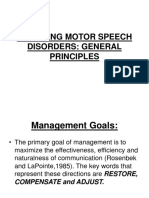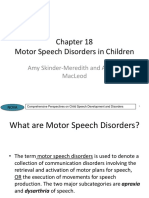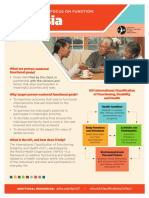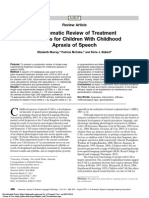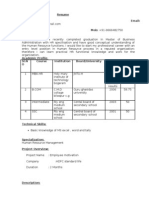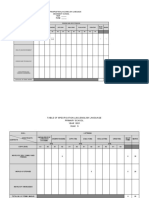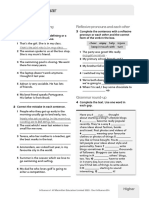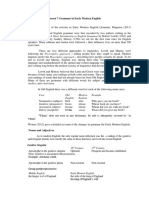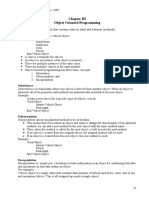0 ratings0% found this document useful (0 votes)
355 viewsClassification of Velopharyngeal Dysfunction
Classification of Velopharyngeal Dysfunction
Uploaded by
Victoria Rojas AlvearThis document classifies and describes different types of velopharyngeal dysfunction (VPD), also known as velopharyngeal inadequacy (VPI). It divides VPD into cleft and non-cleft types. Cleft VPD includes structural issues like unrepaired cleft palate that cause insufficient velopharyngeal closure. Non-cleft VPD involves structural, neurogenic, or learned issues interfering with proper velopharyngeal function. The document provides examples of conditions that fall under each classification of cleft and non-cleft VPD.
Copyright:
© All Rights Reserved
Available Formats
Download as PDF, TXT or read online from Scribd
Classification of Velopharyngeal Dysfunction
Classification of Velopharyngeal Dysfunction
Uploaded by
Victoria Rojas Alvear0 ratings0% found this document useful (0 votes)
355 views1 pageThis document classifies and describes different types of velopharyngeal dysfunction (VPD), also known as velopharyngeal inadequacy (VPI). It divides VPD into cleft and non-cleft types. Cleft VPD includes structural issues like unrepaired cleft palate that cause insufficient velopharyngeal closure. Non-cleft VPD involves structural, neurogenic, or learned issues interfering with proper velopharyngeal function. The document provides examples of conditions that fall under each classification of cleft and non-cleft VPD.
Original Description:
Disfunción velofaríngea
Copyright
© © All Rights Reserved
Available Formats
PDF, TXT or read online from Scribd
Share this document
Did you find this document useful?
Is this content inappropriate?
This document classifies and describes different types of velopharyngeal dysfunction (VPD), also known as velopharyngeal inadequacy (VPI). It divides VPD into cleft and non-cleft types. Cleft VPD includes structural issues like unrepaired cleft palate that cause insufficient velopharyngeal closure. Non-cleft VPD involves structural, neurogenic, or learned issues interfering with proper velopharyngeal function. The document provides examples of conditions that fall under each classification of cleft and non-cleft VPD.
Copyright:
© All Rights Reserved
Available Formats
Download as PDF, TXT or read online from Scribd
Download as pdf or txt
0 ratings0% found this document useful (0 votes)
355 views1 pageClassification of Velopharyngeal Dysfunction
Classification of Velopharyngeal Dysfunction
Uploaded by
Victoria Rojas AlvearThis document classifies and describes different types of velopharyngeal dysfunction (VPD), also known as velopharyngeal inadequacy (VPI). It divides VPD into cleft and non-cleft types. Cleft VPD includes structural issues like unrepaired cleft palate that cause insufficient velopharyngeal closure. Non-cleft VPD involves structural, neurogenic, or learned issues interfering with proper velopharyngeal function. The document provides examples of conditions that fall under each classification of cleft and non-cleft VPD.
Copyright:
© All Rights Reserved
Available Formats
Download as PDF, TXT or read online from Scribd
Download as pdf or txt
You are on page 1of 1
Classification of Velopharyngeal Dysfunction
Figure adapted with permission from Trost-Cardamone (1989) and
Peterson-Falzone, Trost-Cardamone, Karnell, and Hardin-Jones (2006).
Velopharyngeal Dysfunction/VPD
(Velopharyngeal Inadequacy/VPI)
Cleft VPD Non-Cleft VPD
Velopharyngeal Velopharyngeal Velopharyngeal Velopharyngeal
Insufficiency Insufficiency Incompetency Mislearning
(Structural) (Structural) (Neurogenic)
• Phoneme-specific nasal
• Unrepaired cleft palate • Mechanical interference • Congenital or emission
(overt or submucous) (e.g., excessive tonsils acquired primary
or posterior pillar motor/neuromotor • Persisting postoperative
• Postsurgical insufficiencies webbing) control (dysarthria) nasal emission (with
(e.g., palatal length too adequate closure ability)
short post palate repair; • Palatopharyngeal • Motor association/
VPI postadenoidectomy) disproportion (deep motor programming • Compensatory
pharynx) (apraxia) misarticulations
• Ablative palatal lesions • Deafness/hearing
(e.g., cancer, traumatic impairment
injury
Trost-Cardamone, J. E. (1989). Coming to terms with VPI: A response to Loney and Bloem. Cleft Palate Journal, 26(1), 68–70.
11694b
Peterson-Falzone, S. J., Trost-Cardamone, J. E., Karnell, M. P., & Hardin-Jones, M. A. (2006). The clinician’s guide to treating cleft palate speech. St. Louis, MO: Mosby.
You might also like
- DOSSDocument1 pageDOSSKathie-Lee Petsch100% (1)
- Assimil Portugais Bresil Portuguese French PDFDocument3 pagesAssimil Portugais Bresil Portuguese French PDFSalim HBNo ratings yet
- Spark 2 SB TB PDFDocument230 pagesSpark 2 SB TB PDFDarya Bogdan0% (1)
- BGCSE ENGLISH LANGUAGE Newspaper ArticleDocument8 pagesBGCSE ENGLISH LANGUAGE Newspaper ArticleAshley Amantle NtwaetsileNo ratings yet
- PmvbedsideevaluationDocument2 pagesPmvbedsideevaluationapi-114739487No ratings yet
- Natalie Brickner-Slp ResumeDocument1 pageNatalie Brickner-Slp Resumeapi-238387904No ratings yet
- Commentary (The Scarlet Ibis)Document1 pageCommentary (The Scarlet Ibis)hihiNo ratings yet
- Choo Hyun - Wonchuk's Commentary of The Heart SutraDocument85 pagesChoo Hyun - Wonchuk's Commentary of The Heart SutraWu100% (1)
- CommunicationDocument1 pageCommunicationapi-352507025No ratings yet
- Sydney Swallow Questionnaire: Name: - DOB/Sex: - DateDocument4 pagesSydney Swallow Questionnaire: Name: - DOB/Sex: - DateLADY MARIAN CASTAÑEDA MARANTA100% (1)
- GUSS ICU EnglishDocument2 pagesGUSS ICU EnglishFermin LombardiaNo ratings yet
- Typical Swallowing HandoutsDocument12 pagesTypical Swallowing HandoutsnikithaNo ratings yet
- Articulatory Dynamics of Stuttering / Kunnampallil GejoDocument80 pagesArticulatory Dynamics of Stuttering / Kunnampallil GejoKUNNAMPALLIL GEJO JOHN100% (1)
- Objetivos ICF-Speech-Sound-Disorder (ASHA)Document2 pagesObjetivos ICF-Speech-Sound-Disorder (ASHA)labavillaNo ratings yet
- Hoarseness of VoiceDocument6 pagesHoarseness of VoiceJayantiNo ratings yet
- 2014mshahandouts StoeckelDocument37 pages2014mshahandouts StoeckelAna Vogeley100% (1)
- Mbs De-IdentifiedDocument2 pagesMbs De-Identifiedapi-645942287No ratings yet
- Managing Motor Speech DisordersDocument54 pagesManaging Motor Speech DisordersTashi WangmoNo ratings yet
- Stuttering and Auditory Functions..pdf/ KUNNAMPALLIL GEJODocument90 pagesStuttering and Auditory Functions..pdf/ KUNNAMPALLIL GEJOKUNNAMPALLIL GEJO JOHNNo ratings yet
- Dysarthria AssessmentDocument11 pagesDysarthria AssessmentvviraaNo ratings yet
- Applications of ICF in Language DisordersDocument27 pagesApplications of ICF in Language DisordersGowher NazirNo ratings yet
- Aphasia NormativeDocument15 pagesAphasia NormativeMinkushNo ratings yet
- Practice Standards AND Guidelines For Dysphagia Intervention by Speech-Language PathologistsDocument38 pagesPractice Standards AND Guidelines For Dysphagia Intervention by Speech-Language PathologistsAlejandra Quezada GodoyNo ratings yet
- Aphasia and DissociationsDocument17 pagesAphasia and DissociationsJean WallaceNo ratings yet
- 2013 Strand - A Motor Speech Assessment For Children WithDocument17 pages2013 Strand - A Motor Speech Assessment For Children WithgemapesfNo ratings yet
- ApproachesDocument3 pagesApproachesDaisy xoNo ratings yet
- Proforma For Fluency Disorders / KUNNAMPALLIL GEJODocument2 pagesProforma For Fluency Disorders / KUNNAMPALLIL GEJOKUNNAMPALLIL GEJO JOHNNo ratings yet
- Efficacy of Stuttering TherapiesDocument56 pagesEfficacy of Stuttering Therapiespappu713No ratings yet
- Paediatric Dysphagia: How I Inform My Decisions (1) - Penetrating QuestionsDocument3 pagesPaediatric Dysphagia: How I Inform My Decisions (1) - Penetrating QuestionsSpeech & Language Therapy in PracticeNo ratings yet
- Down Syndrome ScriptDocument5 pagesDown Syndrome Scriptapi-324846334No ratings yet
- Prevention Program BrochureDocument2 pagesPrevention Program Brochureapi-232834696No ratings yet
- 2013 What Works - Speech Sound Disorders UpdateDocument26 pages2013 What Works - Speech Sound Disorders UpdatemariaNo ratings yet
- 12724688Document98 pages12724688Melandes Tamiris100% (1)
- Fois ScaleDocument1 pageFois Scalemaria.castillo1047897No ratings yet
- What Is Auditory Verbal Therapy Cochlear ImplantDocument27 pagesWhat Is Auditory Verbal Therapy Cochlear ImplantMariangela MontoyaNo ratings yet
- Lsvt Loud & Lsvt Artic 的设计理念Document9 pagesLsvt Loud & Lsvt Artic 的设计理念ICE TEANo ratings yet
- FTP Phase 3 Soap NoteDocument1 pageFTP Phase 3 Soap Noteapi-313722056No ratings yet
- Speech and Motor Speech Disorders and Intelligibility in Adolescents With Down SyndromeDocument26 pagesSpeech and Motor Speech Disorders and Intelligibility in Adolescents With Down SyndromeMaria Fernanda BahamondezNo ratings yet
- Aphasia Aphasia: Person-Centered Focus On Function: Person-Centered Focus On FunctionDocument2 pagesAphasia Aphasia: Person-Centered Focus On Function: Person-Centered Focus On FunctionSetiawan Uchiha100% (1)
- NursingBedsideSwallowingScreen PDFDocument1 pageNursingBedsideSwallowingScreen PDFLUCASNo ratings yet
- Apraxia TXDocument20 pagesApraxia TXadriricaldeNo ratings yet
- Swallowing ChecklistsDocument5 pagesSwallowing ChecklistsTaylor MayNo ratings yet
- Dysphagia PDFDocument6 pagesDysphagia PDFPavel LeahuNo ratings yet
- GN Chapter 8 Communication DisordersDocument7 pagesGN Chapter 8 Communication Disordersapi-316496339No ratings yet
- Stuttering PDF Form Stuttering and Fluency Parent InputDocument3 pagesStuttering PDF Form Stuttering and Fluency Parent InputCik Siti FadiahNo ratings yet
- Jim DX Report RedactedDocument3 pagesJim DX Report Redactedapi-543869960No ratings yet
- Guidelines For Speech-Language PathologistsDocument37 pagesGuidelines For Speech-Language PathologistsMilia Quin Ri100% (1)
- Speech Perception NotesDocument13 pagesSpeech Perception NotesMuhammad SanwalNo ratings yet
- SB - Pediatrict Vocal NoduleDocument7 pagesSB - Pediatrict Vocal NodulemediNo ratings yet
- Cognitive Linguistic Assessment Protocol For Adults - Kannada Clap-KDocument47 pagesCognitive Linguistic Assessment Protocol For Adults - Kannada Clap-KSureaka PonnusamyNo ratings yet
- Language Assessment in AutismDocument20 pagesLanguage Assessment in AutismDjamel DriciNo ratings yet
- Acoustic and Aerodynamic Assessment of VoiceDocument4 pagesAcoustic and Aerodynamic Assessment of VoicesherinNo ratings yet
- Voice Disorders 3Document9 pagesVoice Disorders 3Lalitha RajaNo ratings yet
- PlayDocument3 pagesPlaybhawnatulsian0% (1)
- Post Stroke WritingDocument9 pagesPost Stroke WritingAdi ParamarthaNo ratings yet
- Topic: Development of Hindi Language Monosyllabic Speech Perception Test Material For ChildrenDocument8 pagesTopic: Development of Hindi Language Monosyllabic Speech Perception Test Material For ChildrenIOSRjournalNo ratings yet
- Efficacy of Stuttering Therapies - PDF /KUNNAMPALLIL GEJODocument24 pagesEfficacy of Stuttering Therapies - PDF /KUNNAMPALLIL GEJOKUNNAMPALLIL GEJO JOHNNo ratings yet
- Diseases of Esophagus.Document3 pagesDiseases of Esophagus.Isabel Castillo100% (2)
- Fluoroscopic Evaluation of Oropharyngeal Dysphagia - Anatomic, Technical, and Common Etiologic Factors - ManuscritoDocument25 pagesFluoroscopic Evaluation of Oropharyngeal Dysphagia - Anatomic, Technical, and Common Etiologic Factors - ManuscritoandrefaelNo ratings yet
- ORLADocument10 pagesORLACarol CoelhoNo ratings yet
- Dysphagia Presentation Auto Saved)Document21 pagesDysphagia Presentation Auto Saved)Tiffani WallaceNo ratings yet
- Voice Proforma / KUNNAMPALLIL GEJO JOHNDocument2 pagesVoice Proforma / KUNNAMPALLIL GEJO JOHNKUNNAMPALLIL GEJO JOHNNo ratings yet
- Hyper-Salivation, A Simple Guide To The Condition, Diagnosis, Treatment And Related ConditionsFrom EverandHyper-Salivation, A Simple Guide To The Condition, Diagnosis, Treatment And Related ConditionsNo ratings yet
- English Practice 54: Question 2: Use The Correct Form of These Words in BracketsDocument3 pagesEnglish Practice 54: Question 2: Use The Correct Form of These Words in BracketsK MakaNo ratings yet
- Sesión 8:reported Speech I & Ii Review / Health Problem CasesDocument22 pagesSesión 8:reported Speech I & Ii Review / Health Problem CasesCeleste A Vilchez CollazosNo ratings yet
- Kokila BiodataDocument2 pagesKokila Biodatakokilanaidu3207No ratings yet
- Regular and Irregular VerbsDocument3 pagesRegular and Irregular VerbsScarlet Medina SanchezNo ratings yet
- Bending GodDocument21 pagesBending GodRoberta Mirela75% (4)
- Player's Guide DraftDocument121 pagesPlayer's Guide DraftGary LutherNo ratings yet
- Jsu Year 5 SpeakingDocument4 pagesJsu Year 5 SpeakingvatsalkrishnasamyNo ratings yet
- The 12-Maqam System and Its Similarity With Indian Ragas (According To Indian Manuscripts)Document27 pagesThe 12-Maqam System and Its Similarity With Indian Ragas (According To Indian Manuscripts)Seyit YöreNo ratings yet
- Gramtran - G5u1 - S.PDF Grammar Unit 1 PDFDocument5 pagesGramtran - G5u1 - S.PDF Grammar Unit 1 PDFBrenda L. CarrasquilloNo ratings yet
- Critical Book Report Drama Performance: Faculty of Languages and Arts State University of Medan 2019Document9 pagesCritical Book Report Drama Performance: Faculty of Languages and Arts State University of Medan 2019Rahma HasibuanNo ratings yet
- Tb1everyone Speak For KidsDocument39 pagesTb1everyone Speak For KidsNurul Puteri Utami100% (1)
- ELC 121 - Week 3 - ListeningDocument9 pagesELC 121 - Week 3 - ListeningAHMAD MUKHRIZ ROSMINo ratings yet
- Interface With ZKTecoDocument5 pagesInterface With ZKTecoAnwar AyNo ratings yet
- Theatre of Roots: Redirecting The Modern Indian Stage (Review)Document6 pagesTheatre of Roots: Redirecting The Modern Indian Stage (Review)Brahma PrakashNo ratings yet
- Language Patterns To Influence NLP Patterns: Dr. Richard NongardDocument13 pagesLanguage Patterns To Influence NLP Patterns: Dr. Richard NongardPradipta MukherjeeNo ratings yet
- Word/Phrase Part of Speech Ipa (Uk) Ipa (Usa) Sample SentenceDocument2 pagesWord/Phrase Part of Speech Ipa (Uk) Ipa (Usa) Sample SentenceHakanNo ratings yet
- Jogo Da MalhaDocument10 pagesJogo Da MalhaJovan KamcevNo ratings yet
- Examen Ingles 1Document1 pageExamen Ingles 1Aaron Crespo RodríguezNo ratings yet
- Museum Analysis AssignmentDocument2 pagesMuseum Analysis AssignmentWill Kurlinkus100% (1)
- English 6 Quarter 1 Week 1 Day 2 June 04, 2019 (Tuesday) I. Contents StandardDocument5 pagesEnglish 6 Quarter 1 Week 1 Day 2 June 04, 2019 (Tuesday) I. Contents StandardJenalyn Esguerra CastilloNo ratings yet
- Lesson 7 Grammar in Early Modern English 1Document4 pagesLesson 7 Grammar in Early Modern English 1YahanieNo ratings yet
- Will, Be Going To, Present ContinuousDocument4 pagesWill, Be Going To, Present Continuousgustavo orueNo ratings yet
- Comp631 (chp3) VB - NET (OOP)Document6 pagesComp631 (chp3) VB - NET (OOP)Myo Thi HaNo ratings yet
- Chapter 26. Higher Cortical FunctionsDocument13 pagesChapter 26. Higher Cortical FunctionsCostrut Laur100% (1)
- Shalem RajuDocument2 pagesShalem RajuSIONNo ratings yet

















